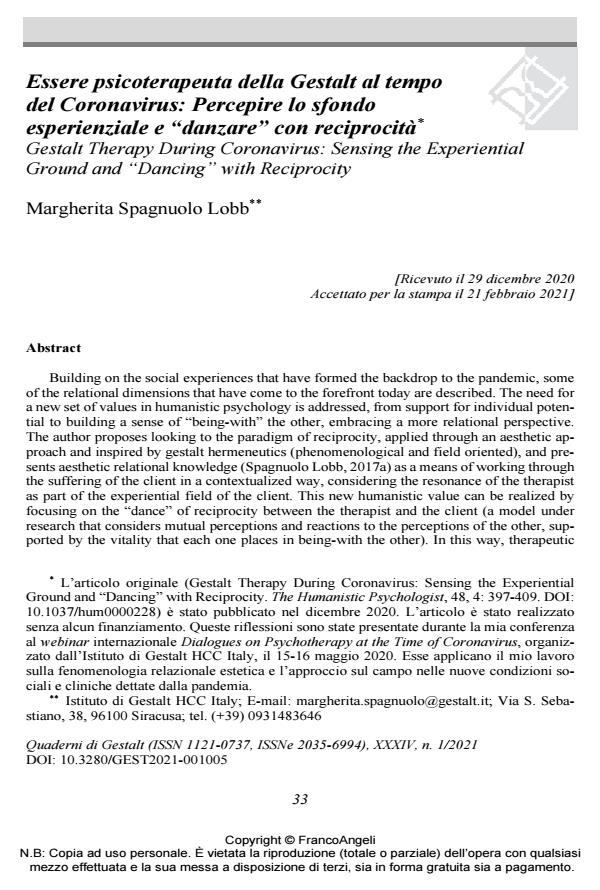Gestalt Therapy During Coronavirus: Sensing the Experiential Ground and "Dancing" with Reciprocity
Journal title QUADERNI DI GESTALT
Author/s Margherita Spagnuolo Lobb
Publishing Year 2021 Issue 2021/1
Language Italian Pages 18 P. 33-50 File size 228 KB
DOI 10.3280/GEST2021-001005
DOI is like a bar code for intellectual property: to have more infomation
click here
Below, you can see the article first page
If you want to buy this article in PDF format, you can do it, following the instructions to buy download credits

FrancoAngeli is member of Publishers International Linking Association, Inc (PILA), a not-for-profit association which run the CrossRef service enabling links to and from online scholarly content.
Building on the social experiences that have formed the backdrop to the pandemic, some of the relational dimensions that have come to the forefront today are described. The need for a new set of values in humanistic psychology is addressed, from support for individual potential to building a sense of "being-with" the other, embracing a more relational perspective. The author proposes looking to the paradigm of reciprocity, applied through an aesthetic approach and inspired by gestalt hermeneutics (phenomenological and field oriented), and presents aes-thetic relational knowledge (Spagnuolo Lobb, 2017a) as a means of working through the suf-fering of the client in a contextualized way, considering the resonance of the therapist as part of the experiential field of the client. This new humanistic value can be realized by focusing on the "dance" of reciprocity between the therapist and the client (a model under research that considers mutual perceptions and reactions to the perceptions of the other, supported by the vitality that each one places in being-with the other). In this way, therapeutic change can in-clude both figure and ground experiences. A consequence of this new value is a turn in the ethical position of the psychotherapist: from a narcissistic effort to be a "good therapist" to an aesthetic attitude that doesn’t deny limits and puts the presence of the other in the foreground. An important consequence for therapists is to take care of themselves so that they are able to deal with the trauma of the pandemic, which is also strengthened through constant dialogue with the professional community.
Keywords: Coronavirus, aesthetic relational knowledge, gestalt therapy, reciprocity, human-istic values.
Margherita Spagnuolo Lobb, Essere psicoterapeuta della Gestalt al tempo del Coronavirus: Percepire lo sfondo esperienziale e "danzare" con reciprocità in "QUADERNI DI GESTALT" 1/2021, pp 33-50, DOI: 10.3280/GEST2021-001005